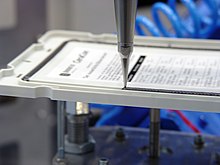Formed in-place foam gaskets
FIPFG is the abbreviation for formed in-place foam gaskets and describes the process of applying paste-like sealing beads to the components to be sealed and the subsequent cross-linking.
Types of seals
Adhesive pads
Until the late 1980s, seals were mostly still applied to components manually in the form of adhesive pads. These adhesive pads were made from foam rubber or foam sheetsCut into the desired geometric shape and thus corresponded exactly to the outline of the component to be sealed. The back of the foam pad was self-adhesive so it could easily be attached to the component. The main disadvantage was the expensive (because manual work) work process and the fact that considerable waste was created through the remains of the foam panels. Another disadvantage was that only two-dimensional geometries could be mapped, which in the case of three-dimensional sealing requirements meant that a seal had to be assembled from several different adhesive pads. In addition, foam or sponge rubber, each cut, is only a conditionally suitable sealant, since it quickly becomes useless in extreme humidity, as it then absorbs the moisture as an open-cell sponge.
Sealing cords
The use of sealing cords represents a further development of the adhesive pad seals. A sealing cord is an endless, circumferential seal that is produced in one piece, divided into defined lengths and then joined together. The simplest form of a sealing cord is the common household rubber ring, which is mostly used to hold objects together and not as a seal. Although these seals usually still have to be attached to the component to be sealed by hand, the other disadvantages of adhesive pad seals have been eliminated. The use of sealing cords enables three-dimensional sealing geometries to be reproduced and there is hardly any material waste. In addition, there is a larger selection of materials (e.g. rubber-like substances) available, which may be better suited for sealing purposes. However, the disadvantage of manual attachment still remains; in addition, a groove is usually required on the component to be sealed, into which the sealing cord can be inserted so that it is fixed.
FIPFG (formed in-place foam gaskets)
The FIPFG sealing technology represents a completely new concept. In contrast to the sealing methods described above, no sealing materials that are solid from the start are not used. A liquid or thixotropic , paste-like sealing compound is prepared in a machine and applied to the component to be sealed via a nozzle in the form of a bead. The sealing material is then dried or crosslinked so that it receives its soft, compressible sealing property. This is where the name of the abbreviation comes from, because the foam gasket ("foam gasket") is applied directly ("in place") to the component to be sealed ("formed"). The main advantage of this technology lies in the mechanical process, because the sealing foam is applied by a robot or an axis system. The components to be sealed are automatically transported in and out (a reverse construction is also possible, in which the nozzle with the sealing material is firmly mounted and the components are guided). Furthermore, three-dimensional seal geometries can be easily reproduced here, and with suitable component materials, no groove is required for receiving the seal, since the cross-linked seal adheres to the component by itself.
See also
literature
- Trade magazine "DICHT! - Trialogue of Sealing and Adhesive Technology . ISSN 1863-4699 .
- Karl F. Berger and Sandra Kiefer: Sealing Technology Yearbook 2008/2009. ISBN 978-3-9811509-2-6 .
- Karl F. Berger and Sandra Kiefer: Seal Technology Yearbook 2007. ISBN 978-3-9811509-0-2 .
- Karl F. Berger and Sandra Kiefer: Seal Technology Yearbook 2006. ISBN 3-7785-2961-7 .
- Karl F. Berger and Sandra Kiefer: Seal Technology Yearbook 2005. ISBN 3-7785-2942-0 .
- Karl F. Berger and Sandra Kiefer: Yearbook of Seal Technology 2004. ISBN 3-7785-2942-0 .
- Karl F. Berger and Sandra Kiefer: Dictionary of Sealing and Gasket Technology (German-English, English-German). ISBN 3-7785-2973-0 .
- Karl F. Berger and Sandra Kiefer: Dictionary of Sealing and Gasket Technology (German-English-Chinese-Pinyin). ISBN 978-3-9811509-1-9 .


